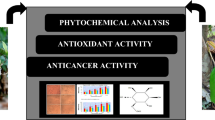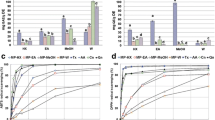Abstract
Allophylus cobbe (L.) Raeusch. belonging to the family Sapindaceae, is a commonly distributed small shrub in Western Ghats of India previously reported for its traditional medicinal properties. It is used for the treatment of various ailments. The present study is aimed at investigating preliminary phytochemicals, inducing the determination of the total phenolic contents, antioxidant assays and anticancer activity of A. cobbe leaf extracts on (DU-145) and (PC-3) cell lines. Preliminary phytochemical screening showed a broad spectrum of secondary metabolites. Highest amount of phenolic content was present in aqueous extract (91.96 ± 0.61 mg/g GAE) and it also proved to have the most potent antioxidant activity at a concentration of 100 mg/ml (64.71 ± 0.15%). IC50 value was (431.10 ± 15.05 µg/mL) for DU-145 and (362.08 ± 24.17 µg/mL) for PC-3 cell lines while the standard drug paclitaxel showed an IC50 value of 0.3 µM/mL. Morphological changes was observed in cancerous cells undergoing apoptosis in human prostate cancer cell lines (DU-145 and PC-3) while the extract showed no cytotoxicity towards normal cells (MEF-L929). It can be concluded that the tested extracts holds significant antioxidant and anticancer activities. However further investigation on lead compounds of A. cobbe will enable its therapeutic use.




Similar content being viewed by others
References
Ankad GM, Upadhya V, Pai SR, Hegde HV, Roy S, Kholkute SD (2014) Erratum to: Total polyphenols, antioxidant and antimicrobial activity of leaves and stem bark extracts of Allophylus cobbe (L.) Raeusch. In: Proceedings of the National Academy of Sciences, India section B: biological sciences 86:145–149
Benzie IF, Strain JJ (1996) The ferric reducing ability of plasma (FRAP) as a measure of “antioxidant power”: the FRAP assay. Anal Biochem 239:70–76
Bhat P, Hegde G, Hegde GR (2012) Ethnomedicinal practices in different communities of Uttara Kannada district of Karnataka for treatment of wounds. J Ethnopharmacol 143:501–514
Bianco FJ, Scardino PT, Eastham JA (2005) Radical prostatectomy: long-term cancer control and recovery of sexual and urinary function (“trifecta”). Urology 66:83–94
Brand-Williams W, Cuvelier ME, Berset CLWT (1995) Use of a free radical method to evaluate antioxidant activity. LWT Food Sci Technol 28:25–30
Deepti K, Umadevi P, Vijayalakshmi G (2012) Antimicrobial activity and phytochemical analysis of Morinda tinctoria Roxb. leaf extracts. Asian Pac J Trop Biomed 2:S1440–S1442
Diplock AT (1997) Will the ‘good fairies’ please prove to us that vitamin E lessens human degenerative disease? Free Radical Res 27:511–532
Eldahshan OA, Abdel-Daim MM (2015) Phytochemical study, cytotoxic, analgesic, antipyretic and anti-inflammatory activities of Strychnos nux-vomica. Cytotechnology 67:831–844
Ghate NB, Hazra B, Sarkar R, Mandal N (2014) In vitro anticancer activity of Spondias pinnata bark on human lung and breast carcinoma. Cytotechnology 66:209–218
Hariharan K, Padmanabha V (2016) Demography and disease characteristics of prostate cancer in India. Indian J Urol 32:103
Igarashi M, Miyazawa T (2001) The growth inhibitory effect of conjugated linoleic acid on a human hepatoma cell line, HepG2, is induced by a change in fatty acid metabolism, but not the facilitation of lipid peroxidation in the cells. Biochim Biophys Acta (BBA) Mol Cell Biol Lipids 1530:162–171
Jain S, Saxena S, Kumar A (2014) Epidemiology of prostate cancer in India. Meta Gene 2:596–605
Kumar M, Rawat P, Dixit P, Mishra D, Gautam AK, Pandey R, Maurya R (2010) Anti-osteoporotic constituents from Indian medicinal plants. Phytomedicine 17:993–999
Luximon-Ramma A, Bahorun T, Soobrattee MA, Aruoma OI (2002) Antioxidant activities of phenolic, proanthocyanidin, and flavonoid components in extracts of Cassia fistula. J Agric Food Chem 50:5042–5047
Muralidharan R, Narasimhan D (2012) Ethnomedicinal plants used against gastrointestinal problem in Gingee Hills of Villupuram district, Tamil Nadu. J Appl Pharm Sci 2:123
Oliveira I, Sousa A, Ferreira IC, Bento A, Estevinho L, Pereira JA (2008) Total phenols, antioxidant potential and antimicrobial activity of walnut (Juglans regia L.) green husks. Food Chem Toxicol 46:2326–2331
Pardhi P, Jain AP, Ganeshpurkar A, Rai G (2010) Anti-microbial, anti-oxidant and anthelmintic activity of crude extract of Solanum xanthocarpum. Pharmacogn J 2:400–404
Prieto P, Pineda M, Aguilar M (1999) Spectrophotometric quantitation of antioxidant capacity through the formation of a phosphomolybdenum complex: specific application to the determination of vitamin E. Anal Biochem 269:337–341
Punekar SA, Lakshminarasimhan P (2011) Flora of Anshi National Park: Western Ghats-Karnataka. Biospheres Publications, Pune
Rackley JD, Clark PE, Hall MC (2006) Complementary and alternative medicine for advanced prostate cancer. Urol Clin North Am 33:237–246
Rastogi RP, Mehrotra BN (2004) Compendium of Indian medicinal plants, vol 1, 1960–1969. Central drug research institute and National institute of science and communication and information resources, CSIR, New Delhi
Rastogi RP, Mehrotra BN, Pastogi RP (1995) Compendium of Indian medicinal plants, vol 4. Central Drug Research Institute; Publications & Information Directorate, p 394
Sen K, Goel A, Rawal S, Mahajan N, Baboo S, Alok S (2010) Antimicrobial activity of Basella rubra leaves. Int J Pharm Sci Res 1:88–91
Sini H, Devi KS (2004) Antioxidant activities of the chloroform extract of Solanum trilobatum. Pharm Biol 42:462–466
Wiygul JB, Evans BR, Peterson BL, Polascik TJ, Walther PJ, Robertson CN, Demark-Wahnefried W (2005) Supplement use among men with prostate cancer. Urology 66:161–166
Wolfe K, Wu X, Liu RH (2003) Antioxidant activity of apple peels. J Agric Food Chem 51:609–614
Acknowledgements
The authors are grateful to Dr. Kotresha K, Department of Botany, Karnataka Science College, Dharwad, Karnataka, for identifying the plant. The authors express their sincere gratitude to the authorities of Dr. Prabhakar Kore Basic Science Research Center, KLE University, Belagavi, Karnataka, India, for providing the laboratory facilities to execute the soxhlet extraction and cell culture experiments. The authors also wish to sincerely thank Dr. Sandeep R. Pai, Assistant Professor, Amity Institute of Biotechnology, Amity University, Mumbai, for his guidance in execution of phenolic content and antioxidant assays.
Author information
Authors and Affiliations
Corresponding author
Ethics declarations
Conflict of interest
The authors declare that they have no conflict of interest.
Rights and permissions
About this article
Cite this article
Ghagane, S.C., Puranik, S.I., Nerli, R.B. et al. Evaluation of in vitro antioxidant and anticancer activity of Allophylus cobbe leaf extracts on DU-145 and PC-3 human prostate cancer cell lines. Cytotechnology 69, 167–177 (2017). https://doi.org/10.1007/s10616-016-0048-1
Received:
Accepted:
Published:
Issue Date:
DOI: https://doi.org/10.1007/s10616-016-0048-1




